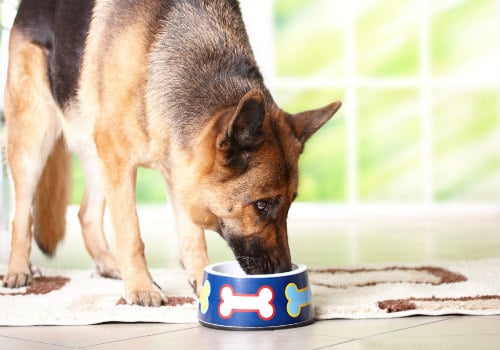Each of the nutrients in your dog’s food plays a vital role in enabling proper bodily functioning. Without protein, he wouldn’t have enough energy… without magnesium, his joints would hurt… and without fiber, his potty time would be unpleasant, to say the least.
Fiber improves digestive health by helping the stomach and intestines operate smoothly. This in turn prevents constipation and diarrhea, and can even help him maintain a healthy weight.
For diabetic dogs, fiber is even more important. It slows digestion and thus prevents blood sugar levels from spiking, so many vets recommend feeding diabetic dogs high-fiber diets that contain around 10% fiber.
But for the average dog, a diet should contain around 5% fiber for optimal digestion. If it dips too much lower than that, he may experience uncomfortable bowel movements, stomach and intestinal pain, poor digestion, and weight issues.
Thankfully, it’s easy to add fiber to your dog’s diet and get his GI tract back to normal. Here are our go-to tips for boosting your dog’s fiber intake and improving his digestive health!
How Much Fiber Is Your Dog Getting?

Before making any changes to your dog’s diet, check to see what he’s already getting. Dog food nutrition labels may not be as detailed as ours, but they still contain plenty of useful facts, including fiber content.
Look in the “Guaranteed Analysis” section for “maximum crude fiber.” This statistic is given in a percentage and should ideally fall around 5 percent.
But even if the fiber content checks out numerically, it doesn’t do your dog any good unless it comes from a high-quality source. You’ll need to check the ingredients list to find out.
Low-quality dog foods utilize ingredients like corn and cellulose to provide fiber. These ingredients provide low-quality fiber and don’t add any other nutritional benefits.
Instead, look for ingredients like fruits, vegetables and unrefined grains, which are nutritious, high-quality sources of fiber. Apples, carrots, brown rice and oats are all examples of such ingredients.
If your dog’s food doesn’t contain enough fiber, or if it contains fiber mainly from low-quality sources, consider switching to a new brand of food that’s formulated with wholesome fiber-rich ingredients. Or read on to learn how to supplement your dog’s current diet with additional fiber.
Easy Ways to Add Fiber to Your Dog’s Diet
We recommend consulting a vet if you want to increase your dog’s fiber intake due to constipation, diarrhea, or other digestive issues. Your vet can run tests to determine if your dog’s symptoms are related to fiber or caused by another illness.
But if your vet does recommend adding fiber to your dog’s diet, try these simple methods.
Swap Processed Treats for Fresh Produce

Yes, your dog loves those store-bought treats, but they’re not the most nutritious things he could be eating.
Fresh fruits and veggies, on the other hand, are much healthier — and in many cases, dogs love them just as much as processed treats!
Apples, lettuce, carrots, green beans and blueberries are all great sources of fiber when given as treats. Just make sure they’re well-washed and chopped into bite-sized pieces before feeding them to your dog.
As with all treats, give fruits and veggies in moderation, so your dog doesn’t consume too much sugar. Plus, too much fiber can actually disrupt digestion and cause more issues than it resolves, so don’t overdo it!
Add a Tasty Topping to Your Dog’s Food
Canned squash or pumpkin makes a simple and effective fiber-rich dog food topping. You don’t need much — around ½ teaspoon for small dogs and 1 tablespoon for big dogs — and most dogs love the taste.
But make sure to check the ingredients on the can first! Avoid any canned pumpkin or squash with extra ingredients like salt, as these can be harmful to dogs.
Bran is another excellent addition to your dog’s diet. It’s the outer shell of grains like oats, wheat and rice, and as a result, it’s loaded with fiber.
However, dry bran can be rough and unpalatable, so we recommend soaking it before giving it to your dog. Soaking the bran softens it, making it easier to eat and pass through the digestive tract.
Try a Fiber Supplement
Store-bought fiber supplements like Metamucil can be used to boost your dog’s fiber intake. Most brands are flavorless, making for easy feeding: just measure it out and sprinkle it on your dog’s food.
The typical per-meal dosage is ½ teaspoon for small dogs and up to 2 tablespoons for very big dogs. If you’re not sure how much to give, ask your vet.
Fiber supplements are safe and relatively affordable. But make sure you don’t overdose your dog: too much fiber can cause diarrhea and gas.

